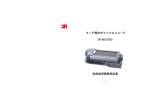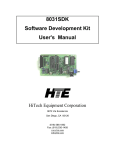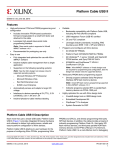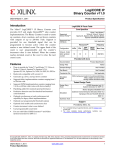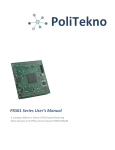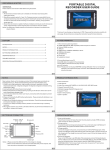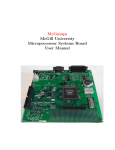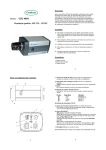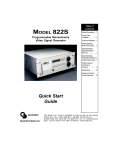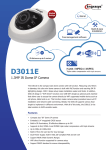Download FPGADEVS6 FPGA Development Kit User`s Manual
Transcript
FPGADEVS6 FPGA Development Kit User's Manual Rev 12.03 www.hte.com/dev/ (800) 748-9172 Int’l:+1(858)679-1569 Fax: (800) 409-9172 www.hte.com/dev [email protected] FPGADEVS6 FPGA Development Kit User's Manual Manual Revision 12.03 March 2012 hte.com/dev [email protected] Copyright © 2012 by HTE. All rights reserved. No part of this material may be reproduced, in any form or by any means, physical or electronic, without the express prior written consent of HTE. Especially our competitiors. But university faculty or students who may copy and distribute at will for any non-commercial purpose. THE FINE PRINT Disclaimer of warranty and limited warranty HTE has attempted to produce a useful, high quality product at a reasonable price. Every Development Board unit has been fully tested and checked for quality prior to shipment. It is warranted to be free of defects in material and workmanship for a period of 90 days after date of purchase. During that time period, HTE will, at no charge to the purchaser of record, repair or replace any defective unit returned to its Service Department in accordance with the following instructions: 1. Phone HTE at the number above between 10 am and 3 pm Pacific Time (GMT-0800) or e-mail [email protected], and obtain a Return Material Authorization (RMA) number. Do not attempt to return the product without an RMA number. 2. Provide HTE with: Model, Serial Number, Proof of Purchase with date, Return Address, and preferred return shipping method. Enclose a clear description of the problem experienced and any sample printouts showing the problem, if possible. 3. Take proper precautions to protect the product during shipping. Mark the package "FRAGILE", and ship via UPS, Parcel Post, or Air Freight, insured and prepaid. Be sure the RMA number appears clearly on the box, as well as any accompanying correspondence. Do not send COLLECT - collect shipments will be refused and returned to sender. This warranty is void in cases of misuse, abuse, abnormal conditions of operation, or attempts to alter or modify the function of the product, or for use within 100 miles of detonation of a nuclear device. The product and written material are provided "AS IS" without warranty of any kind, even if HTE has been advised of that purpose. The entire risk as to the results and performance of the product is assumed by the user. In other words, if you do something any reasonable person (see below) would consider stupid, it’s your own fault. Also, we do not recommend inserting the board in any body cavities, as injury may result. HTE makes no representations or warranties with respect to the contents or use of this product. HTE shall have no liability or responsibility to purchaser or to any person or entity with respect to any liability, loss or damage caused or alleged to be caused, directly or indirectly by this product, including but not limited to any interruption of service, loss of business or anticipatory profits or consequential damage resulting from the use or operation of this product. This device is not intended for use in life support or life critical equipment. Essentially, if you do something stupid, don’t blame us; you’re on your own. HTE reserves the right to make changes to any and all part of this product, at any time, without obligation to notify any person or entity of such changes and does not represent a commitment on the part of HTE . So there. On the other hand, we will consider any reasonable request from any reasonable customer (i.e.: not from a lawyer, attorney, barrister, or solicitor, associates, their employees, contractors, legal consultants or their ilk), and we will often go far out of our way to assist in any way we can. Warranty Registration Please take a moment to e-mail your contact info to [email protected]. This will assure prompt service in the unlikely event a problem occurs. If your company insists on ISO900X certification, please be aware that this only means that we will follow our documented procedures, no matter how foolish they may seem. Just so you know, our first documented standard procedure following a customer request for ISO 900X certification is to laugh in your face and double the price. Trademarks HTE is a trademark of HTE Xilinx, Spartan, and ISE are trademarks of Xilinx Inc. Other trademarks are the property of their owners, whoever they may be. Table of Contents INTRODUCTION ........................................................................................................................................ 7 FEATURES .................................................................................................................................................. 7 COMPONENTS: ........................................................................................................................................... 8 Spartan 6 FPGA General Properties .................................................................................................. 9 GENERAL FEATURES ............................................................................................................................ 10 DESIGN CONSIDERATIONS, SIGNAL NAMES, AND LIMITATIONS.......................................... 11 GETTING STARTED USING A USB THUMB DRIVE: ...................................................................... 14 GETTING STARTED USING A JTAG CABLE: .................................................................................. 15 SAMPLE UCF FILE.................................................................................................................................. 17 EXAMPLE: THE LED VERSION OF “HELLO WORLD” ................................................................................ 18 PROGRAM FPGA DIRECTLY USING JTAG ............................................................................................... 19 PROGRAM SPI PROM CONFIGURATION MEMORY USING JTAG............................................................... 19 PROGRAM SPI PROM CONFIGURATION MEMORY USING USB DRIVE ...................................................... 19 BOARD LAYOUT ..................................................................................................................................... 25 USING THE FPGA WITH THE SWITCH/LED USER I/O BOARD .................................................. 27 SWITCH/LED USER I/O BOARD CONNECTOR PIN ASSIGNMENTS.......................................... 28 APPENDIX A. BOARD DIMENSIONS, CONNECTOR LOCATIONS ...........................................A APPENDIX B. SUMMARY OF SPECIFICATIONS ...........................................................................B APPENDIX C. SCHEMATIC AND BILL OF MATERIALS .............................................................C APPENDIX D. DEVELOPMENT BOARD JUMPERS .......................................................................D APPENDIX E. MCS FILE FORMAT....................................................................................................E APPENDIX F. TROUBLESHOOTING................................................................................................. F APPENDIX G. OEM BOARD VERSION OPTIONS ......................................................................... G APPENDIX H. USING THE OEM VERSION OF THE SBC............................................................ H NOTE: .......................................................................................................................................................... H APPENDIX I. USEFUL WEB SITES ..................................................................................................... I APPENDIX J. OPTIONAL USER I/O BOARD LAYOUT .................................................................... J APPENDIX K. FPGADEVS6 PROBLEM REPORT AND COMMENT FORM ..................................................... K Page 5 User's Manual FPGADEVS6 Page 6 User's Manual FPGA Board with optional User I/O Board Introduction If you’re anxious to start using the board, you can skip ahead to the “Getting Started” section right now! See pages 13 and 14. For those select few people who actually read the instructions first, the rest of this manual provides a detailed description of the board. This manual has been written for the reader who is familiar with digital logic systems. A specific knowledge of the Xilinx FPGA family is not assumed, but it would be advisable for anyone not familiar with this family to obtain and read the relevent documents from the IC manufacturers. A large number of useful documents and sample programs are available from many different web sites, listed on the HTE web site. The term “Development Board” or “Board” is used throughout this manual for the FPGA development board. The term FPGA is used throughout this manual to represent the Spartan 6 family from Xilinx. The abbreviation uC refers to the FTDI USB microcontroller on the board. The terms EE or SPI PROM are used to refer to the SPI serial interface EEPROM. Features • Operates as a stand alone FPGA board • Incorporates standard JTAG to program the FPGA and serial EEPROM • Connects to USB port of a PC for power and communication • Can load configuration files from a USB thumb drive FAT file format • FTDI USB microcontroller Program download / debug via USB • Rapid product development, compatible with most development tools • Low cost OEM version available for dedicated applications The Development Board consists of a minimal configuration Spartan 6 FPGA board containing the absolute minimum stand-alone design. It is suitable for OEM and development applications. The Development Board provides the user with the ability to FPGADEVS6 Page 7 User's Manual download, test, and debug designs for a prototype or production system. The OEM version of the board can be the final target for the application, or it can be customized. The OEM board can be ordered with standard straight through, stackable, or right angle 50 pin connectors, or without any connectors. The Development Board can be stacked or connected horizontally to expansion interfaces such as the optional user I/O board, peripheral interface boards or customer specific designs for a specific application. The FPGA board provides powerful functions to assist the designer in the integration, debug and test phase of FPGA project development. The Development Board provides GPIO pin interface pins on standard 0.1” grid header for connectors. The JTAG and USB processor connectors allow for powering, debugging and downloading programs to the FPGA, USB microcontroller, or serial EEPROM from a PC. In addition, the Development Board can prove invaluable as an educational tool for learning about FPGAs, microcontrollers, and USB interfacing. Components: • Xilinx Spartan-6 XC6SLX9 FPGA in a 144 pin TQFP package 9,152 logic cell equivalents Thirty-two 18K-bit block RAMSs (576K bits) Sixteen DSP48A Slices Two Digital Clock Managers (DCMs) Up to 102 user-defined I/O signals • 4Mbit Serial SPI serial EEPROM, for in-system configuration PROM • JTAG port for low-cost download cable • Dual USB Controller (FTDI VNC2-32) Type A USB Connector Type Mini-B USB Connector • 8 MHz Local Oscillator • Two 50 Pin Expansion I/O Connectors with 84 Pre-Assigned I/O Pins • 4 On-board LED 's • On-Board Power Supply using National LP3906 Quad Regulator +3.3V @ 1.5 A (I/O Operating Voltage) +1.2V @ 1.5 A (FPGA Core Voltage) +3.3V @ 300 mA (FPGA Auxillary Voltage) +1.8V @ 300 mA (Secondary I/.O Operating Voltage) (for an external +5V supply –- USB power typically limited to 500mA) The user can easily: • Design FPGA based products with Host/Device USB Interface • Customize the Board for Small Volume Production • Quickly Test and Debug new configurations • Field Update configuration using only a USB Thumb Drive • Install New Configurations in the Non-volatile SPI configuration PROM In conjunction with any PC capable of running the free ISE Webpack development tools from Xilinx and VNC2 IDE from FTDI, the Development Board becomes a powerful, stand-alone, hardware and firmware development system. The board is capable of supporting either the XC6SLX4 or the XC6SLX9. The development board ships with an ‘LX9, and the OEM version can be ordered with either the ‘LX4 or the ‘LX9. The key FPGADEVS6 Page 8 User's Manual capabilities are shown in the table below. Note that the ‘LX9 is has more than twice the resources of the XC3S200 Spartan 3 device present on most FPGA development boards. Spartan 6 FPGA General Properties Notes: The Data above is taken directly from the Xilinx Spartan 6 product selection guide. FPGADEVS6 Page 9 User's Manual General Features FPGA Xilinx Spartan 6 LX4 or LX9 FPGA in the 144 pin TQFP package, clocked by an 8 MHz crystal oscillator. This frequency makes it easy to generate standard clock rates using the FPGA’s internal clock resources. USB Microcontroller The FTDI VNC2 32 pin USB Microcontroller supports two USB interfaces, a “USB peripheral device” interface with a mini-B connector to connect to a PC or power supply, and a “USB host” type A connector that accommodates a flash USB thumb drive containing a configuration file to be programmed into the Serial EEPROM. Serial EEPROM Configuration Memory An M25P40 non-volatile SPI serial EEPROM configuration memory. Upon power application, the FPGA automatically loads its configuration data from this SPI serial EEPROM. Depending upon what code is present in the USB processor, and whether an external USB drive with a valid configuration fpga.sys file is present in the root directory, the serial EEPROM or the FPGA may also be loaded with different configuration file sources. When the file is not present or there is no USB drive at power up, or if the USB processor is unprogrammed, the FPGA will load the previously programmed configuration file from the serial EEPROM. JTAG Port The 0.1” single row 6 pin JTAG connector P10 allows the FPGA or the serial EEPROM to be programmed using any Xilinx compatible JTAG programming cable (Xilinx parallel or Platform USB cables). JTAG software to be used with the development board includes Xilinx Impact and ChipScope. USB Microcontroller Programming port The 6 pin connector P11 can be used for programming and debug of the on-board FTDI VNC2 USB microcontroller using the free FTDI C programming IDE development tools. Power Requires a single +5 volt supply at 500 mA typical from a standard PC USB port or an external +5V power supply. Dimensions 76,2mm by 76,2mm by 6,4mm high or 3 inches by 3 inches by 0.25 inch high Environmental Storage temperature range -25 to +100°C. Operating temperature range 0 to +50°C. FPGADEVS6 Page 10 User's Manual Design Considerations, Signal Names, and Limitations A description of the Development Board's characteristics, signals, and allocation of resources follows: The Development Board uses approximately 60mA of the standard 500mA available from a standard USB port, leaving approximately 400 mA for external devices. If an external +5V power supply is used, additional power may be drawn from the on-board regulators, subject to their limitations. An auxiliary +1.8V output is also available on a pin that is adjacent to LED D4. The 1.2V FPGA core voltage supply is dedicated to U1. The Development Board is configured to use either single ended or differential I/O standards. Because of this, the pins are numbered by bank, port +/- type, and pin. For example, adjacent pins 5 and 6 on connector P7 are labeled 3P12 and 3N12 to indicate that the pins are connected to bank 3 pair 12, where 3P12 is the positive (+) signal pin and 3N12 is the negative (-) pin of the pair. This facilitates the use of adjacent differential wire pairs if a ribbon cable is connected to the 50 pin connector for moderately high speed differential signalling. Some FPGA and uC I/O pins are not connected or used internally on the board, so they are not available on the external user I/O connectors. The I/O pin banks of the FPGA are connected to +3.3V by default, however the board can be reconfigured to use a different power supply voltage for the 50 pin I/O connections. A jumper can be changed to select either the main +3.3V supply or the auxiliary power supply. The voltage for the banks on either 50 pin connector can be configured independently. The auxiliary supply can be used to operate the FPGA’s I/O banks at any voltage between 1.2 and 3.3 volts, based on the power supply voltage input on the VAR pins of P6 and P7. The I/O may also be supplied by the board’s +1.8V supply by connecting the 1.8V pin to the VAR0 or VAR1 signal on P1, P2, P6 or P7. This allows for the use of different logic voltage interface levels on connectors P6 and P7. Please Note: This board has CMOS devices which can be damaged if exposed to electrostatic fields and discharges. The metallized plastic electrostatic shielding bag provided with the board should be used to protect the board during transport, and grounded conductive workstations and standard ESD precautions should be used whenever possible when handling the board to prevent device damage. FPGADEVS6 Page 11 User's Manual FPGA Board FPGADEVS6 Page 12 User's Manual Operating the Development Board A typical configuration for debugging/development purposes would include: • USB A to mini-B cable • PC or USB Power source • Xilinx ISE Web Pack Development System USB Connections There are two USB connectors: 1) P8 is the USB miniB connector which supplies power and can also be used to communicate with a host PC, subject to appropriate the firmware in the USB microcontroller. 2) P9 is a USB type A connector which will accommodate a USB thumb drive. The standard firmware shipped with the unit will read the thumb drive on pwer up and if a file named fpga.sys is present in the root directory it will be programmed into the SPI configuration PROM on the board. JTAG Connection The JTAG connector, P10 allows programming the FPGA or SPI configuration PROM using a compatible JTAG cable, such as the Xilinx Platform USB cable. FTDI USB Microcontroller Programming Connection P11 is the USB microcontroller chip programming and debug connector this connector can be connected to the FTDI “VNC2 Debug Module” which is a PC board a little larger than a USB type A connector that allows development, debug and programming of the FTDI 16 bit USB microcontroller using the VNC. FPGA Configuration Options The three methods to configure the FPGA are: 1) Download the configuration file directly to the FPGA using a JTAG programmer 2) Program the SPI serial configuration EEPROM through the JTAG cable 3) Load the program from a USB thumb drive. The development cycle for option 1 or 2 is as follows: 1. On a PC, compile your project using ISE and generate the programming file. 2. Use Impact to program the FPGA or the SPI configuration EEPROM. 3. Upon completion and after power-up, the FPGA will load from the EEPROM. Note that programming the FPGA directly through JTAG will result in loss of that FPGA configuration when power is removed, but it is the fastest programming method. Programming the SPI EEPROM configuration memory using JTAG is done indirectly through the FPGA, and takes more than a minute, but the result will be a non-volatile configuration that loads automatically after every power cycle. It is slower because the Impact utility program must first load an SPI programming file into the FPGA, then send the file through the FPGA while the FPGA programs the SPI EEPROM configuration memory, one bit at a time. FPGADEVS6 Page 13 User's Manual Getting Started Using a USB Thumb Drive: GPIO connector P7 Banks 0 & 3 +5V/Gnd pins LEDs D1-D4 Done LED GPIO connector P6 Banks 1 & 2 P8 Power and USB to PC Insert USB Thumb drive here P8 provides power to the board using a powered USB port on a PC or a separate USB power supply. As soon as powert is applied the FPGA will be loaded with the file that is stored in the non-volatile configuration PROM, the Done LED lights, and the FPGA runs. To reprogram the configuration serial PROM using an external USB thumb drive: 1. Use ISE to create and place the desired “fpga.mcs” configuration file in the root of a FAT formatted USB flash (thumb) drive. The fpga.mcs file must be created for a single Spartan 6 FPGA part number XC6SLX9-2 in the TQG144 package and a 4M bit SPI PROM, type M25P40. 2. With power to the board disconnected, plug the USB flash drive into USB connector P9, and apply power. The USB drive acrtivity light flashes as the USB microcontroller reads the fpga.mcs file from the thumb drive and programs the SPI configuration PROM. This will take less than a minute, and when complete, the activity LED on the thumb drive will stop flashing, then D5 (the “Done” LED) will light up and the new FPGA configuration will begin running. 3. Once programming is complete, remove the USB drive, and the FPGA will be configured from the serial PROM will be used on subsequent power cycles. This process takes longer than loading the .bit file to the FPGA from JTAG. For more details and programming using a JTAG cable, see the following pages. FPGADEVS6 Page 14 User's Manual Getting Started Using a JTAG Cable: +5V/Gnd pins LEDs D1-D4 GPIO connector P7 Banks 0 & 3 Done LED GPIO connector P6 Banks 1 & 2 P8 Power and USB to PC Thumb drive USB connector P10 6 pin 0.1” JTAG Connnector For JTAG Programming: Connector P10 - JTAG Connector Pinout Pin Signal Wire Color 1 Vcc Red 2 Gnd Blk 3 TCK Grn 4 TDO Orn 5 TDI Blu 6 TMS Brn 123456 P10 pinout Connector P8 provides power to the board. Before configuring the FPGA or configuration PROM, a powered USB port or separate USB power supply must be connected to P8, or +5V must be supplied by the +5V/Gnd pins to supply power to the FPGADEVS6 Page 15 User's Manual board. +5V is regulated to +3.3V and the other voltages required by the FPGA. The pins on the P6 and P7 GPIO connectors are defined in Appendix and can be configured for 3.3V or VAR. 1) Attach the small end of the A to mini-B USB cable to connector P8 on the board. 2) Attach the large end of the cable to a PC USB port or a USB power supply. When power is connected properly and the FPGA loads a valid configuration file from the EEPROM, the “Done” LED (D5) will light up. 3) Connect your JTAG programming cable to connector P10. At this point, you can use impact, chipscope and other Xilinx ISE tools to program and debug U1, the FPGA, or to program the configuration EEPROM U5. In XIlinx ISE the FPGA Properties must be as shown below for the standard version of the board with a Spartan 6 FPGA part number XC6SLX9-2 in the TQG144 package: The configuration for the ‘LX4 OEM version of the board is the same as above except for the Device part number. FPGADEVS6 Page 16 User's Manual Sample UCF File # # UCF file for FPGA P6 right angle to DevIO P1 # (note: P6/P1 odd/even pin numbers swapped) # Not used: 8MHz clock input # NET "CLOCK" LOC = P123; # LEDs on the FPGA NET "LED1" LOC = NET "LED2" LOC = NET "LED3" LOC = NET "LED4" LOC = board: Active Hi 1=ON 0=OFF P117; P116; P115; P114; # Below: Signals on the optional User I/O Board, when # boards are mated to with right angle connectors # LEDs on the I/O board: Active Hi 1=ON 0=OFF NET "LEDX8" LOC = P47; NET "LEDX7" LOC = P48; NET "LEDX6" LOC = P45; NET "LEDX5" LOC = P46; NET "LEDX4" LOC = P43; NET "LEDX3" LOC = P44; NET "LEDX2" LOC = P40; NET "LEDX1" LOC = P41; # 7 segment display drive: Active Low 0=ON 1=OFF NET "sega" LOC = P102; NET "segb" LOC = P105; NET "segc" LOC = P101; NET "segd" LOC = P97; NET "sege" LOC = P98; NET "segf" LOC = P100; NET "segg" LOC = P104; NET "segdp" LOC = P99; # 7 segment display digit/colon drive: Active Low 0=ON 1=OFF # NET "DIG1" LOC = P92; # left most digit NET "DIG2" LOC = P93; NET "L123" LOC = P87; # COLON NET "DIG3" LOC = P84; NET "DIG4" LOC = P88; # right most digit # Pushbutton switches S1-4 When Depressed = 0 # NET "PBS4" LOC = P80 | PULLUP; NET "PBS3" LOC = P81 | PULLUP; NET "PBS2" LOC = P78 | PULLUP; NET "PBS1" LOC = P79 | PULLUP; # 8 position slide switch S5: # NET "S5_1" LOC = P55 NET "S5_2" LOC = P56 NET "S5_3" LOC = P57 NET "S5_4" LOC = P58 NET "S5_5" LOC = P61 NET "S5_6" LOC = P62 NET "S5_7" LOC = P66 NET "S5_8" LOC = P67 FPGADEVS6 ON=0 OFF = 1 | | | | | | | | PULLUP; PULLUP; PULLUP; PULLUP; PULLUP; PULLUP; PULLUP; PULLUP; Page 17 User's Manual Example: The LED version of “Hello World” The following program is a very simple example intended to show how a VHDL program can be written to run on this board. It blinks the four on-board LEDs D1-4 and places walking ones on the connector I/O pins. ----------------------------------------------------------------------------------- Create Date: 01:13:07 08/06/2009 -- Design Name: -- Module Name: DevFPGA - Behavioral -- Revision: -- Revision 0.01 - File Created -- Additional Comments: ---------------------------------------------------------------------------------library IEEE; use IEEE.STD_LOGIC_1164.ALL; use IEEE.STD_LOGIC_ARITH.ALL; use IEEE.STD_LOGIC_UNSIGNED.ALL; entity DevFPGA is port ( -- Input Pins CLOCK : in std_logic; -- Output Pins LED : out std_logic_vector(4 downto 1) -- Bidirectional Pins ); end DevFPGA; architecture Behavioral of DevFPGA is signal LED_Counter : std_logic_vector(23 downto 0); begin LED(4) LED(3) LED(2) LED(1) MAIN: <= <= <= <= LED_Counter(23); LED_Counter(22); LED_Counter(21); LED_Counter(20); process (CLOCK) begin if CLOCK'event and CLOCK='1' then LED_Counter <= LED_Counter + 1; end if; end process; end Behavioral; The pin definitions in the corresponding UCF File are: NET "CLOCK" LOC = P123; # LEDs on the FPGA NET "LED[1]" LOC = NET "LED[2]" LOC = NET "LED[3]" LOC = NET "LED[4]" LOC = board: Active Hi 1=ON 0=OFF P117; P116; P115; P114; NOTE: The program above was written in VHDL using the Xilinx ISE Web Pack available on the xilinx.com web site. FPGADEVS6 Page 18 User's Manual Program FPGA Directly using JTAG To program the FPGA using a JTAG cable, simply attach the programming cable to P10, the JTAG cable, and use Impact to initialize the JTAG chain, detect, configure and program the FPGA with a .bit file in iMPACT as described in the Xilinx documentation. Program SPI PROM configuration memory using JTAG The first step is to create an SPI file in .mcs format to program the configuration EEPROM using the JTAG cable. See Xilinx application note 974 in the file xapp974.pdf “Indirect Programming of SPI Serial Flash PROMs with Spartan-3A FPGAs.” The procedure is the same for the Spartan 6 and the serial PROM on the development board. Program SPI PROM configuration memory using USB drive To program the configuration PROM using an external USB drive, you must first create and place the desired “.mcs” configuration filefor a 4M bit SPI PROM type M25P40, and the file must be named “fpga.mcs” and placed in the root of a FAT formatted USB drive. FPGADEVS6 Page 19 User's Manual Board Pinout and Configuration Connector and FPGA I/O Pin Configuration: The following tables define the mapping between the various resources on the board and the FPGA pins. 8 MHz On-Board Oscillator Component FPGA Pin Clock Input (GCLK12) 123 On-Board LED's Component FPGA Pin LED 1 117 LED 2 116 LED 3 115 LED 4 114 *Output Signal Logic 1 Turns LED ON FPGADEVS6 Page 20 User's Manual I/O Connector P6 Signal Name FPGA Pin 1 +3.3V 2 GND 3 GND 4 IO_Bank2_P8 41 IO_Bank2_N8 40 6 IO_Bank2_P7 44 7 5 IO_Bank2_N7 43 8 IO_Bank2_P6 46 9 IO_Bank2_N6 45 10 IO_Bank2_P5 48 11 IO_Bank2_N5 47 12 13 IO_Bank2_P4 51 IO_Bank2_N4 50 14 IO_Bank2_P3 56 15 IO_Bank2_N3 55 16 IO_Bank2_P2 58 17 IO_Bank2_N2 57 18 19 IO_Bank2_P1 62 IO_Bank2_N1 61 20 IO_Bank2_P0 67 21 IO_Bank2_N0 66 22 IO_Bank1_P11 75 23 IO_Bank1_N11 74 GND 24 25 GND FPGADEVS6 P6 Pin Vin – Variable 26 IO_Bank1_P10 79 27 IO_Bank1_N10 78 28 29 IO_Bank1_P9 81 IO_Bank1_N9 80 30 IO_Bank1_P8 83 31 IO_Bank1_N8 82 32 IO_Bank1_P7 85 33 IO_Bank1_N7 84 34 IO_Bank1_P6 88 35 IO_Bank1_N6 87 36 IO_Bank1_P5 93 37 IO_Bank1_N5 92 38 39 IO_Bank1_P4 95 IO_Bank1_N4 94 40 IO_Bank1_P3 98 41 IO_Bank1_N3 97 42 IO_Bank1_P2 100 43 IO_Bank1_N2 99 44 IO_Bank1_P1 102 45 IO_Bank1_N1 101 46 IO_Bank1_P0 105 47 IO_Bank1_N0 104 48 GND 49 GND 50 Page 21 User's Manual I/O Connector P7 Signal Name FPGA Pin Vin – Variable 1 +3.3V 2 GND 3 GND IO_Bank3_P12 4 35 5 IO_Bank3_N12 34 6 IO_Bank3_P11 33 7 8 IO_Bank3_N11 32 IO_Bank3_P10 30 9 IO_Bank3_N10 29 10 IO_Bank3_P9 27 11 IO_Bank3_N9 26 12 IO_Bank3_P8 24 13 IO_Bank3_N8 23 14 IO_Bank3_P7 22 15 IO_Bank3_N7 21 16 IO_Bank3_P6 17 17 IO_Bank3_N6 16 18 IO_Bank3_P5 15 19 IO_Bank3_N5 14 20 IO_Bank3_P4 12 21 IO_Bank3_N4 11 22 IO_Bank3_P3 10 23 IO_Bank3_N3 9 24 GND 25 GND FPGADEVS6 P7 Pin 26 IO_Bank3_P2 8 IO_Bank3_N2 7 27 28 IO_Bank3_P1 6 29 IO_Bank3_N1 5 30 31 IO_Bank3_P0 2 IO_Bank3_N0 1 32 IO_Bank0_P7 142 33 IO_Bank0_N7 141 34 IO_Bank0_P6 140 35 IO_Bank0_N6 139 36 IO_Bank0_P5 138 37 IO_Bank0_N5 137 38 IO_Bank0_P4 134 39 IO_Bank0_N4 133 40 IO_Bank0_P3 132 41 IO_Bank0_N3 131 42 IO_Bank0_P2 127 43 IO_Bank0_N2 126 44 IO_Bank0_P1 121 45 IO_Bank0_N1 120 46 IO_Bank0_P0 119 47 IO_Bank0_N0 118 48 GND 49 GND 50 Page 22 User's Manual P8 - USB Type Mini-B USB Signal P8 Pin +5V (Input) 1 D- 2 D+ 3 nc 4 GND 5 USB Signal P9 Pin +5V (Output) 1 D- 2 D+ 3 GND 4 P9 - USB Type A P10 - JTAG Programming Header FPGADEVS6 JTAG Signal P10 Pin +3.3V (Output) 1 GND 2 TCK 3 TDO 4 TDI 5 TMS 6 Page 23 User's Manual Bank 1 and 2 Operating Voltage Configuration P1 Voltages P1 Pin +3.3V (Default) 1 VCCO_1 2 Vin_Variable 3 Bank 0 and 3 Operating Voltage Configuration P2 Voltages P2 Pin +3.3V (Default) 1 VCCO_0 2 Vin_Variable 3 FPGA Mode Configuration P5 Mode P5-1 to P5-2 Master Closed (Default) Slave Open Status LED D5 FPGA Configured ON FPGA Not Configured OFF Configuration LED D5 FPGADEVS6 Page 24 User's Manual Board Layout Component Locations and I/O Pins FPGADEVS6 Page 25 User's Manual Using the FPGA with the switch/LED user I/O Board The FPGA board may be used with the general purpose switch/LED user I/O board when connected as shown below. The two boards are designed to mate horizontally as shown, or if ordered with custom connectors, they can be stacked so that the user I/O board stacks on top of the FPGA board. Connector P1 on user I/O board mates to P6 on FPGA board Four digit 7 segment common anode LED display with DP & colon 123456 8 discrete LEDs Power applied through USB cable here 4 pushbutton switches 8 slide switches P10 JTAG Pinout Color-Signal-Pin# Red - Vcc - 1 Blk - Gnd - 2 Grn - TCK - 3 Orn - TDO - 4 Blu - TDI - 5 Brn - TMS - 6 FPGADEVS6 Page 27 User's Manual Switch/LED user I/O Board Connector Pin Assignments Note that these pins are for the P1 connector on the I/O board, and if the board is connected using right angle connectors to another board, the odd and even pin numbers will be switched. If the board uses straight-through or stacking ribbon or header connectors, then the pin numbering will be identical for boath boards. (See I/O board schematic: “DevIO Rev ?? Schematic1.pdf” file for details.) Pusbutton Inputs Switches S1-4 Signal P1 Pin Number PB-1 29 PB-2 30 PB-3 27 PB-4 28 Signal P1 Pin Number S5-1 15 S5-2 16 S5-3 17 S5-4 18 S5-5 19 S5-6 20 S5-7 21 S5-8 22 Signal P1 Pin Number LED 1 11 LED 2 12 LED 3 9 LED 4 10 LED 5 7 LED 6 8 LED 7 5 LED 8 6 8 Position Switch S5 Inputs Discrete LEDs D1-8 FPGADEVS6 Page 28 User's Manual Four Digit 7 Segment LED Display with Colon I/O Board P1 Connector Pin Definitions FPGADEVS6 Signal P1 Pin Number Vin 1,2 GND 3,4,25,26,49,50 Segment a 46 Segment b 48 Segment c 45 Segment d 41 Segment e 42 Segment f 44 Segment g 47 Segment dp 43 Character Enable 1 37 Character Enable 2 38 Character Enable 3 33 Character Enable 4 36 Colon Enable 35 Page 29 User's Manual Sample UCF File for use with I/O Board # UCF file for FPGA P6 right angle to DevIO P1 # (note: P6/P1 odd/even pin numbers swapped) # Not used: 8MHz clock input # NET "CLOCK" LOC = P123; # LEDs on the FPGA NET "LED1" LOC = NET "LED2" LOC = NET "LED3" LOC = NET "LED4" LOC = board: Active Hi 1=ON 0=OFF P117; P116; P115; P114; # LEDs on the I/O board: Active Hi 1=ON 0=OFF NET "LEDX8" LOC = P47; NET "LEDX7" LOC = P48; NET "LEDX6" LOC = P45; NET "LEDX5" LOC = P46; NET "LEDX4" LOC = P43; NET "LEDX3" LOC = P44; NET "LEDX2" LOC = P40; NET "LEDX1" LOC = P41; # 7 segment display drive: Active Low 0=ON 1=OFF NET "sega" LOC = P102; NET "segb" LOC = P105; NET "segc" LOC = P101; NET "segd" LOC = P97; NET "sege" LOC = P98; NET "segf" LOC = P100; NET "segg" LOC = P104; NET "segdp" LOC = P99; # 7 segment display digit/colon drive: Active Low 0=ON 1=OFF NET "DIG1" LOC = P92; NET "DIG2" LOC = P93; NET "L123" LOC = P87; # COLON NET "DIG3" LOC = P84; NET "DIG4" LOC = P88; # Pushbutton switches S1-4 When Depressed=0 NET "PBS4" LOC = P80; NET "PBS3" LOC = P81; NET "PBS2" LOC = P78; NET "PBS1" LOC = P79; # 8 position slide switch S5: ON=0 OFF = 1 NET "S5_1" LOC = P55; NET "S5_2" LOC = P56; NET "S5_3" LOC = P57; NET "S5_4" LOC = P58; NET "S5_5" LOC = P61; NET "S5_6" LOC = P62; NET "S5_7" LOC = P66; NET "S5_8" LOC = P67; FPGADEVS6 Page 30 User's Manual Appendix A. FPGADEVS6 Board Dimensions, Connector Locations Page A User's Manual Appendix B. Summary of Specifications The development board specs are standard: Xilinx Spartan-6 XC6SLX9 FPGA in a 144 pin TQFP package 9,152 logic cell equivalents Thirty-two 18K-bit block RAMSs (576K bits) Sixteen DSP48A Slices Two Digital Clock Managers (DCMs) Up to 102 user-defined I/O signals 4Mbit Serial SPI EEPROM, for in-system configuration PROM JTAG port for low-cost download cable Dual USB Controller (FTDI VNC2-32) USB 2.0 operation defined by VNC2 Specs Type A USB Connector for flash drive Type Mini-B USB Connector for power and PC communication 8 MHz Local Oscillator Two 50 Pin Expansion I/O Connectors with 84 Pre-Assigned I/O Pins 4 On-board LEDs On-Board Power Supply using National LP3906 Quad Regulator +3.3V @ 1.5 A (I/O Operating Voltage) +1.2V @ 1.5 A (FPGA Core Voltage) +3.3V @ 300 mA (FPGA Auxillary Voltage) +1.8V @ 300 mA (Secondary I/.O Operating Voltage) Note: Above load peaks apply only for an external +5V power supply. USB power is typically limited to 500mA @5V = 2.5W max. All specifications are subject to change. FPGADEVS6 Page B User's Manual Appendix C. Schematic and Bill of Materials See separate schematic and BOM PDF files available at http://www.hte.com/dev FPGADEVS6 Page C User's Manual Appendix D. Development Board Jumpers Jumper Pins Name Shorted Function P1 1-2 * Select I/O voltage for I/O banks 1 & 2 on P6 P2 1-2 * Select I/O voltage for I/O banks 0 & 3 on P7 P5 1-2 * Master Mode jumper (In=Master by default) +5V +5VDC Power GND Gnd Return for +5V power * Note: Asterisk (*) means the default jumper is a trace on the the board. Normally, the jumpers are not installed. The traces can be cut by the user or by special order at the factory prior to being shipped, so 0.1” jumper pins and plugs can be installed. FPGADEVS6 Page D User's Manual Appendix E. MCS File Format The .mcs file is generated using Xilinx ISE in the Implementation pane, on the Deisgn Tab process “Generate Target PROM” to create the file. By default, the board will load a file named fpga.sys from the root directory of a FAT formatted USB flash drive installed at power up. The file format is described below. The .mcs (Intel hex) data file formats begin with a 9-character prefix and end with a 2character suffix. The byte count must be equal to the number of data bytes in the record. Data record and end-of-file record are the two types of records. The number of bytes per record is variable. Each record begins with a colon, which is followed by a 2-character byte count. The 4 characters following the byte count is the address of the first data byte. Each byte is represented by 2 hex digits that equals to the number of bytes in each record. It ends with the checksum. :BCAAAATTHH . . . HHCC : Start character (colon) BC The hexadecimal number of bytes in the record. If BC = 0 the it is the end-offile record. AAAA Address in hexadecimal of first data byte in the record. TT Record type. If TT = 00 then data record. If TT = 01 then end-of-file record HH One data byte in hexadecimal notation. CC Checksum is the two's complement of binary summation of preceding bytes in record including the byte count, address and record type. FPGADEVS6 Page E User's Manual Appendix F. Troubleshooting No LEDs light up at all Explanation: No power to board. Action: Check and correct power connection. LEDs light, but are very dim Explanation: No valid FPGA configuration loaded in the serial PROM. Action: FPGADEVS6 Program with a known good FPGA configuration file. Page F User's Manual Appendix G. OEM Board Version Options You can use the development board and later purchase the OEM version populated with those connectors and features that are actually used in your final application to customize or reduce the cost of the board. Custom configurations may be subject to a minimum order quantity. Contact HTE for more information. The board can be ordered with either a Spartan 6 ‘LX9 or a ‘LX4 device. The optional parts that can be left off the OEM board include: • 50 pin GPIO connectors P6, P7 • USB microcontroller U3 • USB connectors P8, P9 The configuration options and jumpers that can be added include: • Jumpers/plugs P1, P2, P5 • Customer Specified I/O power • USB VNC2 microcontroller programming/debug connector P11 FPGADEVS6 Page G User's Manual Appendix H. Using the OEM version of the SBC Essentially, the OEM (Original Equipment Manufacturer) versions of the board is a minimum configuration version of the Development Board. The OEM version is typically a lower cost unit, as it does not have the components which are only needed for development of programs. It does not have the following items that are included on the development board: 1. 2. 3. 4. 5. 6. 50 Pin I/O Connector P6. 50 Pin I/O Connector P7. Connector P8. Connector P9. The FTDI USB IC and crystal. The OEM jumper connections are supplied with jumper pins in the default settings by default. Note that the OEM board may be ordered with some or all of the above and other custom configurations. Contact HTE for more information. Once development has been completed on the Development Board, the FPGA configuration must be programmed into the SPI serial configuration EEPROM, typically using the JTAG connector. Optionally, the USB thumb drive programming can also be specified at time of order. Power can be provided by the external connections at the top left corner of the board using the pins labeled +5V and GND. The following is the pinout for the power connector at the top left corner of the board: Pin Description 1. +5v in. This pin can be used instead of the USB connector P8 if you have an externally regulated +5v supply. This powers the on-board regulator to deliver power to all components on the board. 2. Ground NOTE: The +5V power input is NOT reverse polarity protected. Reversing the +5V and Gnd connections will damage the board. FPGADEVS6 Page H User's Manual Appendix I. Useful Web sites Below is a list of useful web sites, related to the board, accessories and development tools. http://www.hte.com/dev/ The HTE web site has other resources. http://www.xilinx.com Xilinx is the manufacturer of the Spartan 6 ICs and related FPGA architectures, and has documentation, app notes, and free software utilities that will work with the FPGA board. FPGADEVS6 Page I User's Manual Appendix J. Optional User I/O Board Layout Pin 1 FPGADEVS6 Page J User's Manual Appendix K. Problem Report and Comment Form Please complete this form if you discover any software or hardware problems, documentation problems, or would like to suggest product enhancements. Duplicate this form if you need additional copies and/or attach extra pages if necessary. ___ Hardware Problem ___ Programming Problem ___ Documentation Problem ___ Product Enhancement Date: ________________________ Serial #: ______________ Product: ______________________ Version #: ____________ Name: ___________________________ Title: _____________ Company: _________________________________________ City: ________________________ State: _____ Zip: ________ Country: _____________________ Phone: (______) ____________________ Ext: ____________ Please describe the problem, how to reproduce it and your suggested correction. Or, decscribe documention problems or suggest enhancements that you would like to see added to this product. E-mail or fax form to: HTE Attn: Technical Support (800) 748-9172 Fax: (800) 409-9172 http://www.hte.com Or e-mail [email protected] FPGADEVS6 Page K User's Manual









































